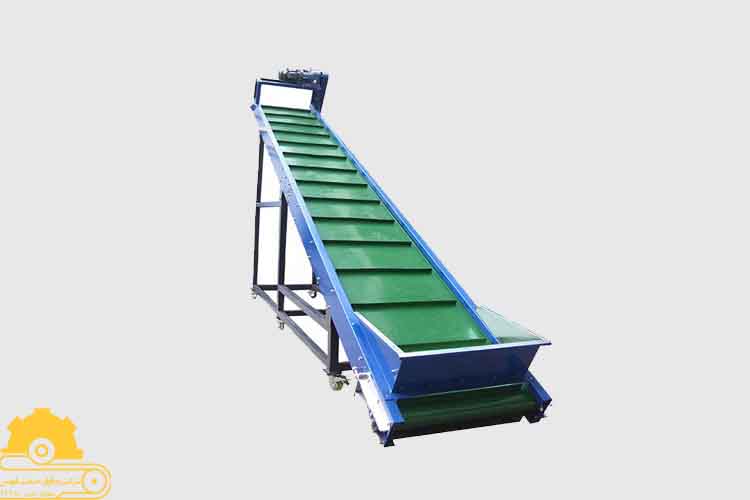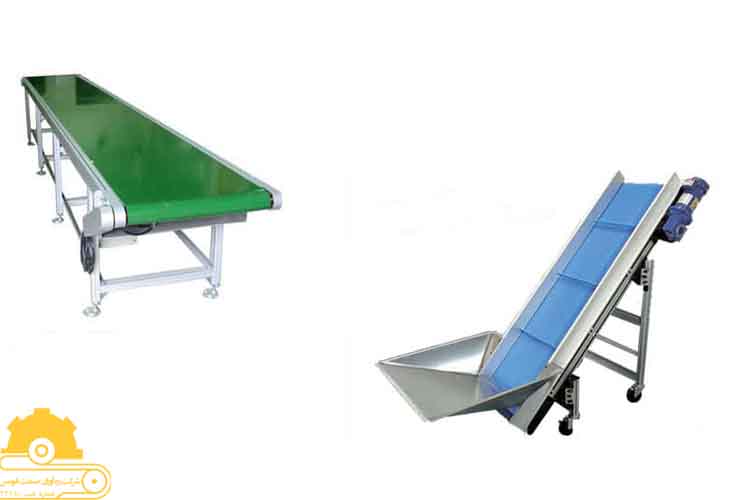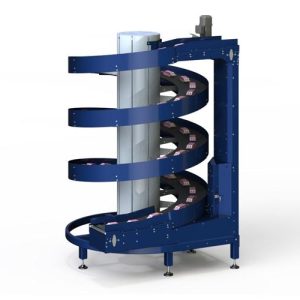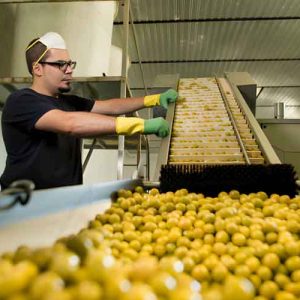Description
A stud conveyor is a device for transferring and moving materials, which uses different parts, especially a special belt to carry out such a process, i.e. transfer materials. These strips are usually made of materials such as polyethylene, polystyrene or metal and are connected to each other by various methods such as sparking, welding or gluing.
The gutter conveyor is generally used in industry, mining and construction. They are used to transport materials such as soil, sand, mustard and other heavy materials. Due to its high efficiency and low costs, this transmission system is preferred by many industries. In this article we will provide useful information about this product, please stay with us.
Introduction of stud conveyor
Conveyor belt is a mechanized transportation system that is used to transfer materials continuously and without interruption. This system is generally used in various industries such as mining, manufacturing plants, refineries, ports and warehouses.
The stud conveyor is usually composed of a long packing system that includes a packed conveyor belt and various conveying systems such as towers, height adjustment devices, high efficiency, weight flow and speed adjustment.
This product can be horizontal, vertical or diagonal and can carry light to heavy loads. It also transports materials such as stone, gravel, sand, coal, cement, grain, food and other portable materials.
The advantages of using stud conveyors include continuous transportation, high efficiency, saving time and money, reducing access to materials, reducing waste, and increasing safety.
Conveyor belts have become so versatile that you can see them anywhere from a grocery store to an e-commerce warehouse, says the popular site Redline.
Stud Conveyor Specifications
The characteristics of the stud conveyor are very special and unique, and this product has faced a series of differences compared to similar devices, pay attention to the following;
- Structure: The stud conveyor is made up of several interconnected strip pieces, which are connected using special nuts, bolts and nuts. This structure allows the conveyor belt to withstand heavy loads.
- Belt material: Stud-type conveyor belts are usually made of materials such as polyester, nylon, polyethylene, or reinforced steel. The material of the tape must be selected according to the characteristics of the transported material to prevent scratches and damage to the tape.
- Belt Width: The width of the stud conveyor is usually between 500mm and 3000mm. It is necessary to choose the appropriate width of the tape depending on the volume and type of transported material.
- Movement speed: The stud conveyor can move at different speeds, which can be adjusted according to the type of material and working conditions. Higher speed increases the capacity but decreases loading accuracy.
- Conveying system: The stud conveyor includes various conveying systems, which include high efficiency, height and speed adjustment systems, towers, weight flow adjustment devices and intelligent control systems.
- Types of Conveyors: Stud-type conveyors are available in different types such as flat conveyors, wave conveyors, multi-layer conveyors, chain conveyors, and magnetic conveyors. It is necessary to choose the right type depending on the type of material and working conditions.
- Safety: The gutter conveyor must be properly equipped with safety systems. These systems include locking and tape protection systems, fire fighting and fire extinguishing systems, fall prevention systems and notification and notification systems.
- Maintenance and repairs: The stud conveyor must be periodically repaired and maintained for better performance. This includes replacing wear parts, adjusting and gluing tape, cleaning and lubricating mechanical parts.
- Deformability: Some stud conveyors have the ability to deform and change the direction of movement, which can be adjusted depending on the type of system and needs.
- Foundation and supporting structures: The stud conveyor must be installed on supporting structures to ensure its strength and stability. These structures usually include towers, foundations and fixed and mobile systems.
These features and specifications of the gutter conveyor include its most important features, which help users to choose and use this system.
Application of stud conveyor
Stud conveyor has very wide applications in various industries. In the following, we mention some of its main uses;
- Mining industry: In mines, chute conveyors are used to transport minerals such as coal, ore, iron ore, limestone and gypsum. This mechanized transportation system continuously moves materials from the mine to other parts of the processing system or warehouses.
- Construction industry: In the construction industry, the gutter conveyor is used to transport construction materials such as sand, cement, and building blocks. This system can move materials from the production source to the production line, warehouses, or appropriate discharge locations.
- Food Industry: In the food industry, stud conveyors are used to transport food such as grain, flour, sugar, salt, raw materials and finished products. This system automatically transfers materials from processors, mills and various devices to the packaging system or warehouses.
- Metallurgical and refinery industries: In the metallurgical and refinery industries, gutter type conveyors are used to transport materials such as mineral ore, iron ore, aluminum, copper and gold. This system continuously transports materials from mining or processing units to other refining or processing units.
- Agricultural Industry: In the agricultural industry, stud conveyors are used to transport materials such as grains, seeds, fodder, horticultural products and agricultural materials. This system continuously transfers materials from fields, processing systems and warehouses to packaging or transportation systems.
- Ports and warehouses: In ports and warehouses, chute conveyors are used to transport containers, bags, packages and heavy loads from ships to warehouses or vice versa. This system continuously transfers loads automatically from the loading or unloading system to the warehouse or transportation systems.
- Waste Industry: In the waste industry, chute conveyors are used to transport waste and solid waste to landfill and incineration systems. This system continuously transports waste from collection points to different burial or incineration sites.
- Automotive industry: In the automotive industry, this product will be used to transport car parts such as body, mechanical parts and accessories. This system continuously moves parts from production lines to assembly lines or warehouses.
Stud conveyors are used as a reliable and efficient mechanized transportation system in a variety of industries, helping to improve performance, increase productivity, and reduce costs.
last word
Stud conveyor is an efficient and economical transportation system that helps various industries such as mining, construction and heavy industries. With the ability to transfer heavy, small, horizontal or vertical loads, this system not only reduces transportation costs, but also improves safety and productivity.
By performing regular maintenance and continuous monitoring, the gutter conveyor can continuously provide valuable service. The large group of industry leaders produces this product and provides it to consumers with the benefit of the best modern technologies.






Reviews
There are no reviews yet.